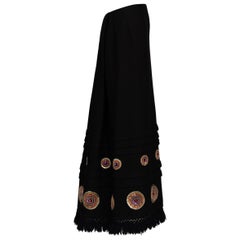Pleated Crystal Bohemian
Recent Sales
1970s French Skirts
Pleated Crystal Bohemian For Sale on 1stDibs
How Much is a Pleated Crystal Bohemian?
Lanvin Paris for sale on 1stDibs
The career of Jeanne Lanvin (1867–1946) and her eponymous brand began with a millinery apprenticeship in the late 19th century. Today, Lanvin Paris is a globally revered company and is among the oldest French fashion houses still in existence. It is renowned for its exquisite and sought-after vintage evening dresses, shoes, skirts and other garments and accessories and for having dressed such high-profile celebrities as Meryl Streep, Natalie Portman, Kim Kardashian and Sienna Miller.
In 1889, when her apprenticeship came to an end, the young French designer Jeanne Lanvin opened a custom hat shop on the rue Boissy d’Anglas in Paris. Four years later, she moved her business into a much more prominent space on the rue du Faubourg Saint-Honoré, one of the world’s most famous luxury fashion districts.
The new Maison Lanvin was big enough to display the pieces she would design for her daughter, Marguerite, who was born in 1897. The relationship between Lanvin and her daughter would be at the core of the brand, with a 1907 photograph of Jeanne and Marguerite in matching outfits inspiring the fashion house’s enduring logo.
In 1908, Lanvin launched a line of children’s clothing, one of the first such moves in high-end fashion. When mothers came in to buy the clothes, they often asked for similar designs for themselves.
Lanvin decided to introduce a women’s wear line with pieces that had a youthful femininity. This would grow to encompass everyday clothing, dresses, coats, lingerie and furs, as well as menswear, perfume and household items. Once she became a member of the Chambre Syndicale de la Couture (Parisian Fashion Council) in 1909, her title officially switched from milliner to designer.
Along with her stylish designs, Lanvin identified the importance of brand identity through fabric colors, opening a dye factory in Nanterre, France. There the distinctive “Lanvin blue” was produced, so even if her designs were copied, the colors could never be exactly reproduced.
After Jeanne Lanvin's death, her daughter, Marguerite Marie-Blanche de Polignac, took over and a series of talented artistic directors would propel the brand through the trends of the 20th century, including Jules François Crahay, Dominique Morlotti, Alber Elbaz and, most recently, Bruno Sialelli. In 2018, Lanvin was acquired by the Fosun Fashion Group, which is now focused on celebrating Lanvin’s heritage while pushing it into a new chapter.
Find vintage Lanvin Paris clothing and accessories on 1stDibs.
Finding the Right skirts for You
For everyday casual wear, elevating your look at the office or making a dramatic entrance at a formal event, authentic designer and vintage skirts are reliably versatile garments.
Skirts have been around for thousands of years. A woman’s straw skirt found in an Armenian cave is believed to have been handwoven in 3,900 B.C., and long, full skirts were worn by men and women in Ancient Egypt and Ancient Mesopotamia. Over time, the hemlines might have changed significantly but the skirt’s integral role in fashion has remained in place.
By the early 1900s, skirt hemlines had crept up slightly to ankle-length height from the densely layered floor-length style that dominated the Victorian era — a radical shift. As women in the United States began to live more active lives during the 1920s, designers such as Gabrielle “Coco” Chanel sought to free them from the long skirts and other constrictions that persevered in fashion by introducing her first little black dress. That same decade, she debuted her perfume, Chanel No. 5, as well as the Chanel suit with a fitted skirt, inspired by the boxy lines of men’s clothing and employing a sporty tweed.
Advancements in swimwear during the 1920s and 1930s also reflected a climbing hemline. Visionary designers such as Elsa Schiaparelli eventually pushed the boundaries of modesty with her backless suit, but women still wore long garments in public. Also during the so-called Roaring ’20s, short flapper dresses that fell at the knees and boasted a free-flowing sack-like silhouette, as well as chic beaded evening gowns and floral day dresses, paired fabulously with the dazzling jewelry of the era. This proved to be just a fleeting deviation from prevailing social convention, however. Skirts grew longer again in the 1930s, even if bows and other embellishments were added. As women entered the workforce in large numbers, clean lines accentuated curves and flared slightly where the material resolved at the ankles.
After World War II, France earned recognition as the center of fashion design for women. It was the golden age of haute couture, and women, quick to dispense of the drab utilitarian wartime garb that hung in their closets, pined for luxurious, elegant skirts designed by Christian Dior, Chanel, Givenchy and others, which were splashed across the pages of Vogue and Harper’s Bazaar in richly colored photographs shot by the likes of Richard Avedon and David Bailey. The 1960s introduced narrow pencil skirts and provocative minis emblazoned with geometrically dazzling patterns or bright floral prints by designers such as Emilio Pucci, Pierre Cardin and Lilly Pulitzer. By the 1970s, women felt emboldened to wear different varieties of this all-purpose garment, exploring wraps, crushed velvet maxis and other styles crafted by Halston, André Courrèges, Yves Saint Laurent and others.
On 1stDibs, find a wide range of designer and vintage skirts for any gender by Prada, Dolce & Gabbana, Alexander McQueen and more. Whether it’s a skirt that can be altered to suit a specific style or an addition that’s ready to join your cherished collection, find exactly what you’re looking for today.
